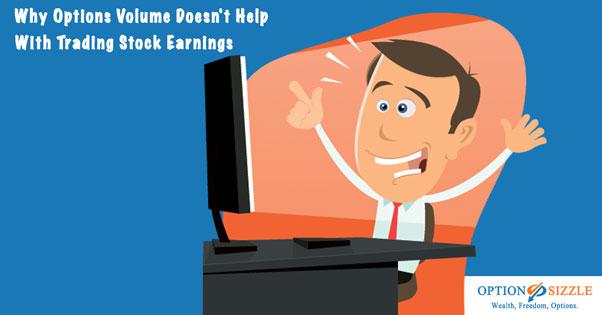
We've seen some decent two sided trading in the market so far this year. Despite having higher overall volatility, we've seen some larger than expected earnings moves. For example, Apple, Amazon, Starbucks, McDonalds, Netflix, Disney and Google all had greater moves than what was implied by their ATM straddle. (For a refresher on what that means, check out Don't Trade Earnings Before You Read This).
As I've written several times in the past, tracking institutional options activity is a forward looking indicator. Similar to how a poker player shows a "tell" when they're holding a good hand or bluffing…certain type of options activity can scream very bullish or bearish action.
However, it's not simple to detect if you don't know what you're looking for. That's why I wrote the SIZZLE Method Report. I'll be honest, I've noticed through emails and social media that most are not going about it the right way.
For example, tracking options activity ahead of earnings is generally a worthless endeavor… let me explain why.
For the most part, we don't know how the market will react to a company's earnings release. They can beat on expectations, guide lower and the stock could tank. Good news can be viewed as bad…and bad news can be viewed as good. Trying to make sense of it all can drive a person crazy and into losing trades.
Let's try to think about why someone would place certain types of orders ahead of an earnings release, and why it might not be what it seems like.
1. Large Call Buyers:
Generally this could be viewed as a bullish bet. However, let's assume a large fund doesn't want to be long a stock ahead of earnings, simply because of the randomness involved. They might sell their shares and buy calls instead. By doing this, they now have a limited risk position. In addition, they can participate towards an upside move with less capital.
Imagine they're long the stock and it has a massive move lower after the earnings announcement…that's just bad risk management. However, buying some upside calls with defined risk is one way to have exposure without the potential of taking a devastating loss. In other words, large call buying ahead of an earnings announcement can be viewed as a stock substitute. It is not extremely bullish as one might, especially if they're just watching option volume.
On 1/28, the largest non-spread order in Alibaba Group Holding Limited, BABA, was a 1,482 lot, a trader came in and bought April 17th, 115 calls for $2.34 a piece. The following day, BABA dropped nearly 9% on their earnings release. If this was a stock substitute, that trade might have saved them a lot of money.
2. Large Call Sellers:
Generally this could be viewed as a bearish bet. However, let's assume a fund is long the stock. They know that the earnings could go either way…but instead of closing out their stock position, they sell calls against it. Since implied volatility is elevated ahead of earnings, they are collecting some juicy premium.
Of course, selling calls against your stock position will help reduce their cost basis and soften the blow if the stock trades lower after the earnings release.
On the other hand, let's assume the stock trades higher. To the naked eye, those calls sold might look really bad. However, there is a good chance that they were sold against a stock position. If the stock trades higher or unchanged…they are most likely making money on the trade.
3. Large Put Buyers
Generally this could viewed as a bearish bet. However, let's assume a fund is long the stock ahead of earnings. This time, they don't want to limit their upside by selling calls…instead, they just want to to limit their downside. They can achieve this by buying puts against their stock position…creating what is called a "married put" or synthetic long call.
For example, the largest single options trade in Netflix, NFLX, on 1/20 was a put buyer. A trader came in and bought 800 1/23 $250 puts when the stock was trading around $338 per share. Was this trader expecting NFLX to have a poor earnings or where they hedging a long stock position?
Well, we'll never know, however, after their earnings release, NFLX traded above $405 per share. I wouldn't be surprised if that trade was a hedge.
As you can see, options activity that normally appears bullish or bearish can be very confusing ahead of an earnings release. With that said, as an indicator it does poorly. Believe me, I've seen options activity that was so bullish ahead of earnings…only to see the shares of the stock price crumble after the earnings release.
By the way, some of the positions mentioned in this piece are called "synthetics" …you can read more about them in Putting Context Behind Your Options Strategy. In addition, it's covered extensively in my new book Fearless Investing With Options (limited time price of $14.95).
Have you ever fallen into this earnings trap; thinking that a stock was bound to go up, or down, based on what you thought the options volume provided to you ahead of their release? I know it's happened to me, but the I'd love to hear about it.
Thank you so much for reading and contributing to the conversation.
To your wealth, freedom & options!
